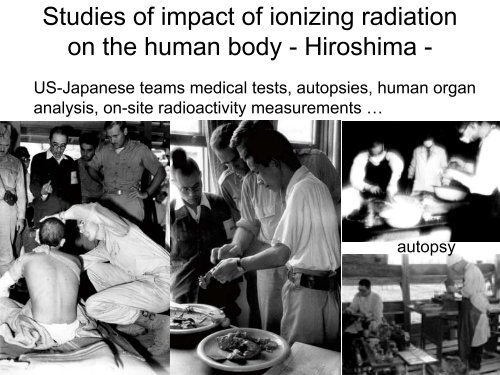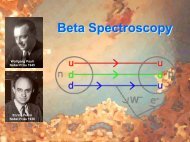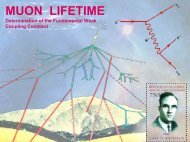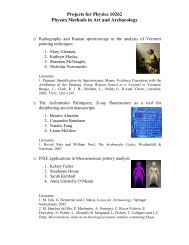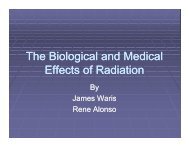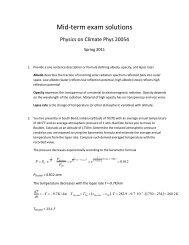Studies of impact of ionizing radiation on the human body ...
Studies of impact of ionizing radiation on the human body ...
Studies of impact of ionizing radiation on the human body ...
Create successful ePaper yourself
Turn your PDF publications into a flip-book with our unique Google optimized e-Paper software.
<str<strong>on</strong>g>Studies</str<strong>on</strong>g> <str<strong>on</strong>g>of</str<strong>on</strong>g> <str<strong>on</strong>g>impact</str<strong>on</strong>g> <str<strong>on</strong>g>of</str<strong>on</strong>g> <str<strong>on</strong>g>i<strong>on</strong>izing</str<strong>on</strong>g> <str<strong>on</strong>g>radiati<strong>on</strong></str<strong>on</strong>g><br />
<strong>on</strong> <strong>the</strong> <strong>human</strong> <strong>body</strong> - Hiroshima -<br />
US-Japanese teams medical tests, autopsies, <strong>human</strong> organ<br />
analysis, <strong>on</strong>-site radioactivity measurements …<br />
autopsy
Radiati<strong>on</strong> Exposure Types<br />
Ir<str<strong>on</strong>g>radiati<strong>on</strong></str<strong>on</strong>g><br />
External<br />
C<strong>on</strong>taminati<strong>on</strong><br />
Internal<br />
C<strong>on</strong>taminati<strong>on</strong><br />
* **<br />
* * *<br />
*<br />
<br />
<br />
<br />
<br />
<br />
*
Schematic Model <str<strong>on</strong>g>of</str<strong>on</strong>g> Radi<strong>on</strong>uclide Uptake<br />
Intake:<br />
Ingesti<strong>on</strong><br />
Inhalati<strong>on</strong><br />
Surface<br />
Lung Clearance<br />
Uptake:<br />
GI<br />
Tract<br />
Lymph<br />
Nodes<br />
Lung<br />
Skin<br />
1. Intact<br />
2. Wounds<br />
Blood<br />
(Recycle)<br />
Kidney<br />
Depositi<strong>on</strong> Sites<br />
Excreti<strong>on</strong>:<br />
Feces<br />
Urine<br />
1. Whole Body<br />
2. B<strong>on</strong>e 90 Sr<br />
3. Liver 232 Th<br />
4. Muscle 137 Cs<br />
5. Thyroid 131 I
Radiati<strong>on</strong> interacting with cell molecules
Sequence <str<strong>on</strong>g>of</str<strong>on</strong>g> Events in Indirect Acti<strong>on</strong><br />
↓<br />
T 1/2 in sec<br />
Incident X-ray phot<strong>on</strong>s<br />
↓<br />
10 -15 Fast electr<strong>on</strong>s<br />
↓<br />
10 -5 I<strong>on</strong> radicals<br />
↓<br />
10 -5 Free radicals<br />
↓<br />
Macromolecular changes from<br />
breakage <str<strong>on</strong>g>of</str<strong>on</strong>g> chemical b<strong>on</strong>ds<br />
↓<br />
Biological effects<br />
days<br />
- cell killing<br />
generati<strong>on</strong><br />
- mutati<strong>on</strong><br />
years<br />
- carcinogenesis
Energy dependence <str<strong>on</strong>g>of</str<strong>on</strong>g> <str<strong>on</strong>g>radiati<strong>on</strong></str<strong>on</strong>g> damage<br />
Linear energy transfer (LET): amount <str<strong>on</strong>g>of</str<strong>on</strong>g> energy deposited per unit track length
Acute Radiati<strong>on</strong> Syndrome<br />
• Signs and symptoms experienced by individuals<br />
exposed to acute whole <strong>body</strong> ir<str<strong>on</strong>g>radiati<strong>on</strong></str<strong>on</strong>g>.<br />
• Data collected largely through Japanese atomic<br />
bomb survivors at Hiroshima and Nagasaki.<br />
• Limited number <str<strong>on</strong>g>of</str<strong>on</strong>g> accidents at nuclear<br />
installati<strong>on</strong>s.<br />
• Clinical radio<strong>the</strong>rapy.<br />
• Well-characterized animal data base.<br />
• LD 50 dose <str<strong>on</strong>g>of</str<strong>on</strong>g> <strong>human</strong> is ~4.5 Gy.<br />
• Lethal Dose is ≥ 8 Gy
Human lethality as functi<strong>on</strong> <str<strong>on</strong>g>of</str<strong>on</strong>g> Dose<br />
A 50% lethality<br />
is reached at<br />
an accumulated<br />
dose <str<strong>on</strong>g>of</str<strong>on</strong>g> 450 cGy<br />
=450 rad=4.5 Gy.<br />
A 100 rad dose<br />
is survivable.<br />
A 800 rad dose is<br />
lethal.
Prodromal Radiati<strong>on</strong> Syndrome<br />
• Early symptoms that appear after exposure to<br />
whole <strong>body</strong> <str<strong>on</strong>g>radiati<strong>on</strong></str<strong>on</strong>g>:<br />
– gastrointestinal: nausea, vomiting, diarrhea,<br />
anorexia<br />
– neuromuscular: easy fatigability<br />
• Effect is dose dependent:<br />
– Varies in time <str<strong>on</strong>g>of</str<strong>on</strong>g> <strong>on</strong>set<br />
–Severity<br />
–Durati<strong>on</strong>
For people who died<br />
within 2 days to 2 m<strong>on</strong>ths<br />
after bomb explosi<strong>on</strong><br />
Survival Chance
Radiati<strong>on</strong> Side Effects<br />
<str<strong>on</strong>g>radiati<strong>on</strong></str<strong>on</strong>g> sickness
Early Lethal Effects<br />
Hematopoietic syndrome:<br />
• Cause <str<strong>on</strong>g>of</str<strong>on</strong>g> death at doses
Early Lethal Effects<br />
Gastrointestinal syndrome:<br />
• Occurs at dose >10 Gy <str<strong>on</strong>g>of</str<strong>on</strong>g> gamma-rays or its<br />
equivalence.<br />
• Death usually occurs within 3 to 10 days.<br />
• Symptoms due largely to depopulati<strong>on</strong> <str<strong>on</strong>g>of</str<strong>on</strong>g> <strong>the</strong> epi<strong>the</strong>lial<br />
lining <str<strong>on</strong>g>of</str<strong>on</strong>g> <strong>the</strong> GI tract by <str<strong>on</strong>g>radiati<strong>on</strong></str<strong>on</strong>g>.<br />
• No <strong>human</strong> has survived <str<strong>on</strong>g>radiati<strong>on</strong></str<strong>on</strong>g> dose >10 Gy.<br />
• Clinical symptoms include nausea, vomiting, and<br />
prol<strong>on</strong>g diarrhea, dehydrati<strong>on</strong>, loss <str<strong>on</strong>g>of</str<strong>on</strong>g> weight, complete<br />
exhausti<strong>on</strong>, and eventually death.
Early Lethal Effects<br />
Cerebrovascular syndrome:<br />
• Identified at doses >100 Gy <str<strong>on</strong>g>of</str<strong>on</strong>g> gamma-rays.<br />
• Death occurs within hours from cardiovascular and<br />
neuromuscular complicati<strong>on</strong>s.<br />
• Clinical manifestati<strong>on</strong>s include severe nausea,<br />
vomiting within minutes <str<strong>on</strong>g>of</str<strong>on</strong>g> exposure, disorientati<strong>on</strong>,<br />
loss <str<strong>on</strong>g>of</str<strong>on</strong>g> muscular co-ordinati<strong>on</strong>, respiratory distress,<br />
seizures, coma and death.
Radiati<strong>on</strong>-induced Mutagenesis<br />
• Radiati<strong>on</strong> DOES NOT produce new, unique mutati<strong>on</strong>s, but<br />
increases <strong>the</strong> incidence <str<strong>on</strong>g>of</str<strong>on</strong>g> <strong>the</strong> same mutati<strong>on</strong>s that occur<br />
sp<strong>on</strong>taneously.<br />
• Mutati<strong>on</strong> incidence in <strong>human</strong>s is DOSE and DOSE-RATE<br />
dependent.<br />
• A dose <str<strong>on</strong>g>of</str<strong>on</strong>g> 1 rem (10 mSv) per generati<strong>on</strong> increases<br />
background mutati<strong>on</strong> rate by 1%.<br />
• Informati<strong>on</strong> <strong>on</strong> <strong>the</strong> genetic effects <str<strong>on</strong>g>of</str<strong>on</strong>g> <str<strong>on</strong>g>radiati<strong>on</strong></str<strong>on</strong>g> comes<br />
almost entirely from animal and IN VITRO studies.<br />
• Children <str<strong>on</strong>g>of</str<strong>on</strong>g> A-bomb survivors from Hiroshima and<br />
Nagasaki fail to show any significant genetic effects <str<strong>on</strong>g>of</str<strong>on</strong>g><br />
<str<strong>on</strong>g>radiati<strong>on</strong></str<strong>on</strong>g>.
Tumor evoluti<strong>on</strong> in animal tests
Radiati<strong>on</strong> Carcinogenesis<br />
• A stochastic late effect.<br />
• No threshold, an all or n<strong>on</strong>e effect.<br />
• Severity is not dose related.<br />
• Probability <str<strong>on</strong>g>of</str<strong>on</strong>g> carcinogenesis is dose dependent.<br />
• Leukemia has <strong>the</strong> shortest latency period <str<strong>on</strong>g>of</str<strong>on</strong>g> ~5 years.<br />
Solid tumors have a latency period <str<strong>on</strong>g>of</str<strong>on</strong>g> ~20 to 30 years.<br />
• Total cancer risk for whole <strong>body</strong> ir<str<strong>on</strong>g>radiati<strong>on</strong></str<strong>on</strong>g> is <strong>on</strong>e death<br />
per 10 4 individuals exposed to 1 rem.
Nagasaki Effects
Purpura, Vomiting, …<br />
Purpura, or bleeding under <strong>the</strong> skin, is <strong>on</strong>e <str<strong>on</strong>g>of</str<strong>on</strong>g> <strong>the</strong> symptoms <str<strong>on</strong>g>of</str<strong>on</strong>g> acute<br />
<str<strong>on</strong>g>radiati<strong>on</strong></str<strong>on</strong>g> sickness. The heavily exposed survivors experienced fever,<br />
nausea, vomiting, lack <str<strong>on</strong>g>of</str<strong>on</strong>g> appetite, bloody diarrhea, epilati<strong>on</strong>, purpura,<br />
sores in <strong>the</strong>ir throat or mouth (nasopharyngeal ulcers), and decay and<br />
ulcerati<strong>on</strong> <str<strong>on</strong>g>of</str<strong>on</strong>g> <strong>the</strong> gums about <strong>the</strong> teeth (necrotic gingivitis). The time <str<strong>on</strong>g>of</str<strong>on</strong>g><br />
<strong>on</strong>set <str<strong>on</strong>g>of</str<strong>on</strong>g> <strong>the</strong>se symptoms depends <strong>on</strong> <strong>the</strong> exposure level.
L<strong>on</strong>g term effects - blindness<br />
Radiati<strong>on</strong> damage to epi<strong>the</strong>lial<br />
Cells. Damaged cells move to<br />
<strong>the</strong> back <str<strong>on</strong>g>of</str<strong>on</strong>g> <strong>the</strong> eye and cause<br />
lens opacity by blocking light.<br />
Occurs with 50% chance for<br />
people with dose <str<strong>on</strong>g>of</str<strong>on</strong>g> ~500 rad.
Epilati<strong>on</strong> – severe loss <str<strong>on</strong>g>of</str<strong>on</strong>g> hair<br />
Hair loss is a comm<strong>on</strong> sign <str<strong>on</strong>g>of</str<strong>on</strong>g> <str<strong>on</strong>g>radiati<strong>on</strong></str<strong>on</strong>g> exposure & sickness.<br />
Severe epilati<strong>on</strong> (2/3 hair loss) occurs at doses <str<strong>on</strong>g>of</str<strong>on</strong>g> >200 rad.<br />
2km from hypocenter
Hemogram<br />
blood <str<strong>on</strong>g>impact</str<strong>on</strong>g> <str<strong>on</strong>g>of</str<strong>on</strong>g> 300 rad exposure
Radiati<strong>on</strong> <str<strong>on</strong>g>impact</str<strong>on</strong>g><br />
<strong>on</strong> b<strong>on</strong>e marrow<br />
100 rad = 1 Gy ≈ 1 Sv<br />
Radiati<strong>on</strong> >2 Gy suppresses<br />
normal b<strong>on</strong>e marrow functi<strong>on</strong>s<br />
and causes l<strong>on</strong>g term mutati<strong>on</strong><br />
<str<strong>on</strong>g>of</str<strong>on</strong>g> red or white blood cells<br />
MORTALITY RATE ( % )
Leukemia<br />
When leukemia develops, <strong>the</strong><br />
<strong>body</strong> produces large numbers<br />
<str<strong>on</strong>g>of</str<strong>on</strong>g> abnormal blood cells. In<br />
most types <str<strong>on</strong>g>of</str<strong>on</strong>g> leukemia, <strong>the</strong><br />
abnormal cells are white blood<br />
cells.<br />
An increase in <strong>the</strong> number <str<strong>on</strong>g>of</str<strong>on</strong>g><br />
leukemia cases was first noted<br />
in <strong>the</strong> late 1940s. As <str<strong>on</strong>g>of</str<strong>on</strong>g> 1990,<br />
<strong>the</strong>re were 176 leukemia deaths<br />
am<strong>on</strong>g 50,113 survivors with<br />
significant exposures (>0.5Gy).<br />
It is estimated that about 90 <str<strong>on</strong>g>of</str<strong>on</strong>g><br />
<strong>the</strong>se deaths are associated with<br />
<str<strong>on</strong>g>radiati<strong>on</strong></str<strong>on</strong>g> exposure.<br />
Risk<br />
Time <str<strong>on</strong>g>radiati<strong>on</strong></str<strong>on</strong>g> dose received<br />
Latent period<br />
Period at risk<br />
Risk curve<br />
0 4 30<br />
Time (years)<br />
Leukemia Latency and Time at Risk Periods
Leukemia – case <str<strong>on</strong>g>of</str<strong>on</strong>g> Sadako
L<strong>on</strong>g range genetic effects<br />
Chromosomes observed during<br />
cell divisi<strong>on</strong>. Abnormal <strong>on</strong>es are<br />
marked by grey arrow.<br />
Observed increase with dose<br />
indicates l<strong>on</strong>g term genetic effects


